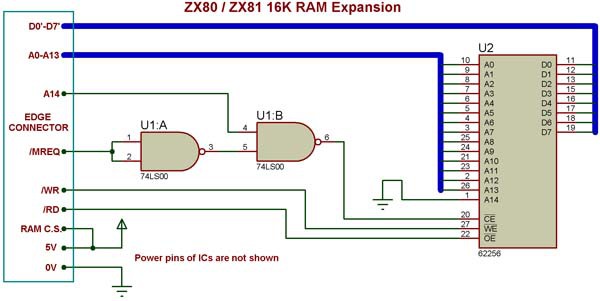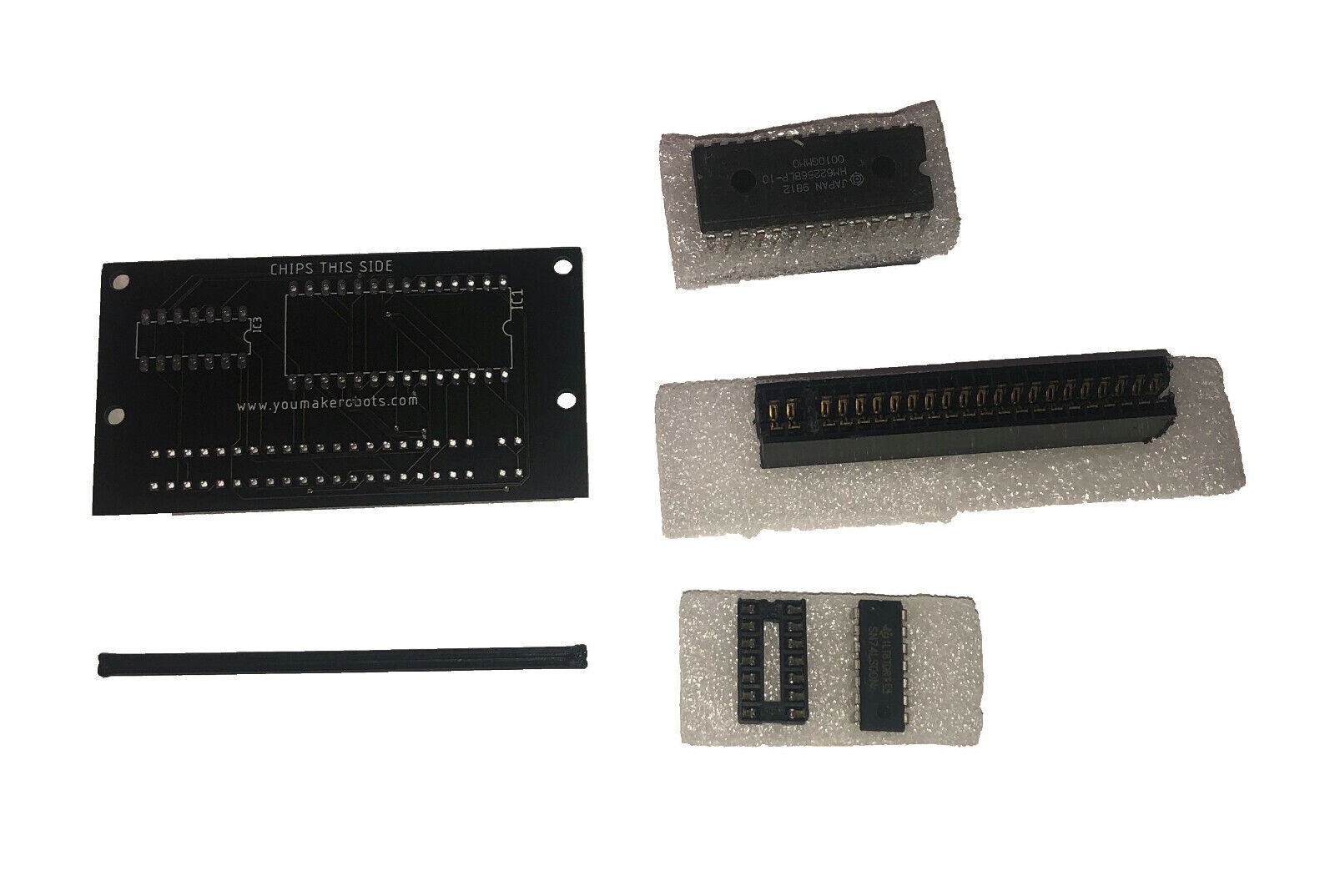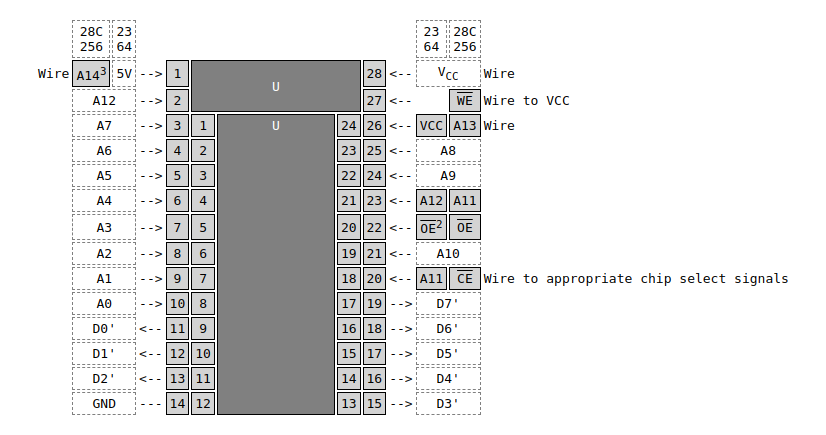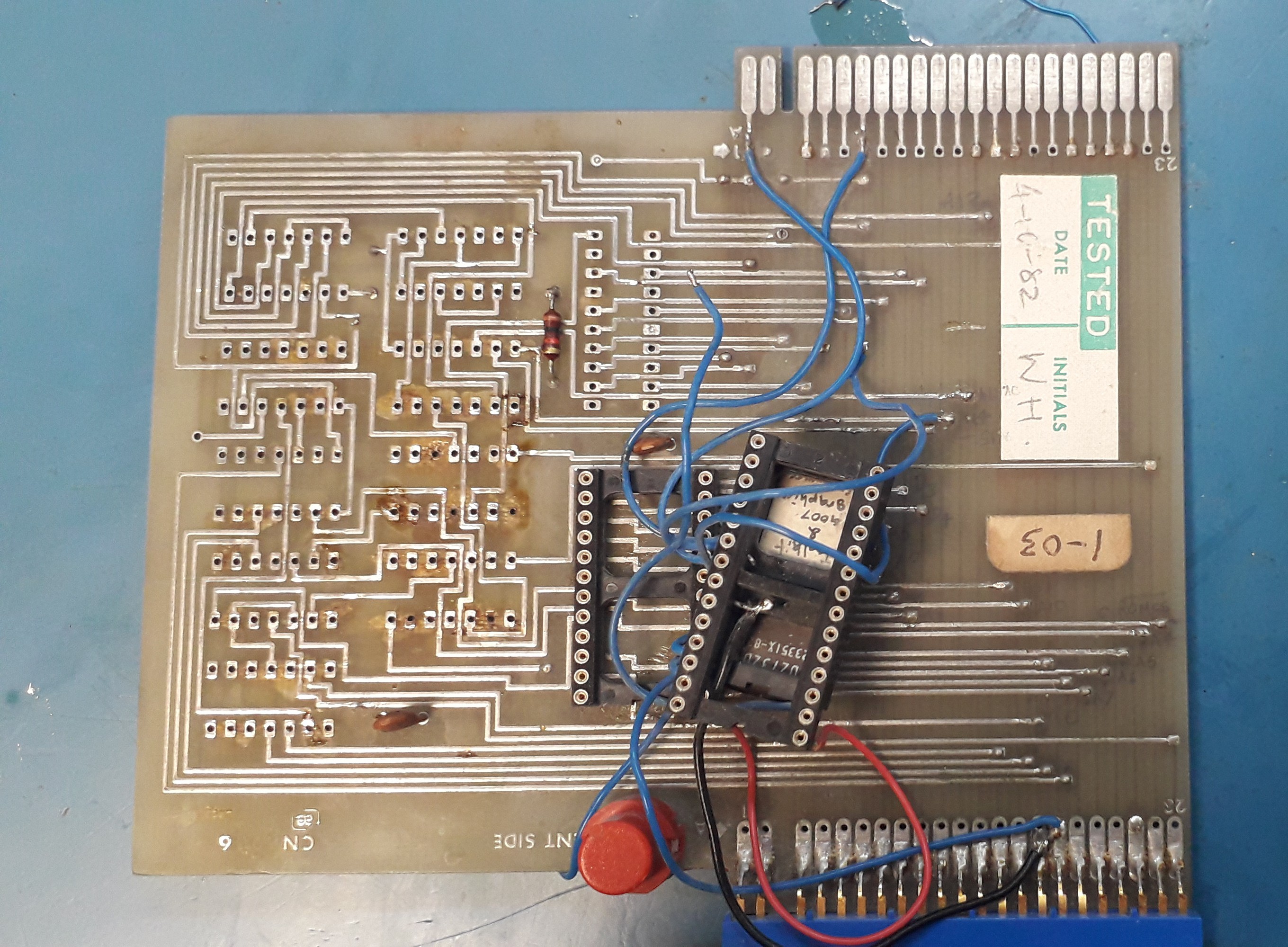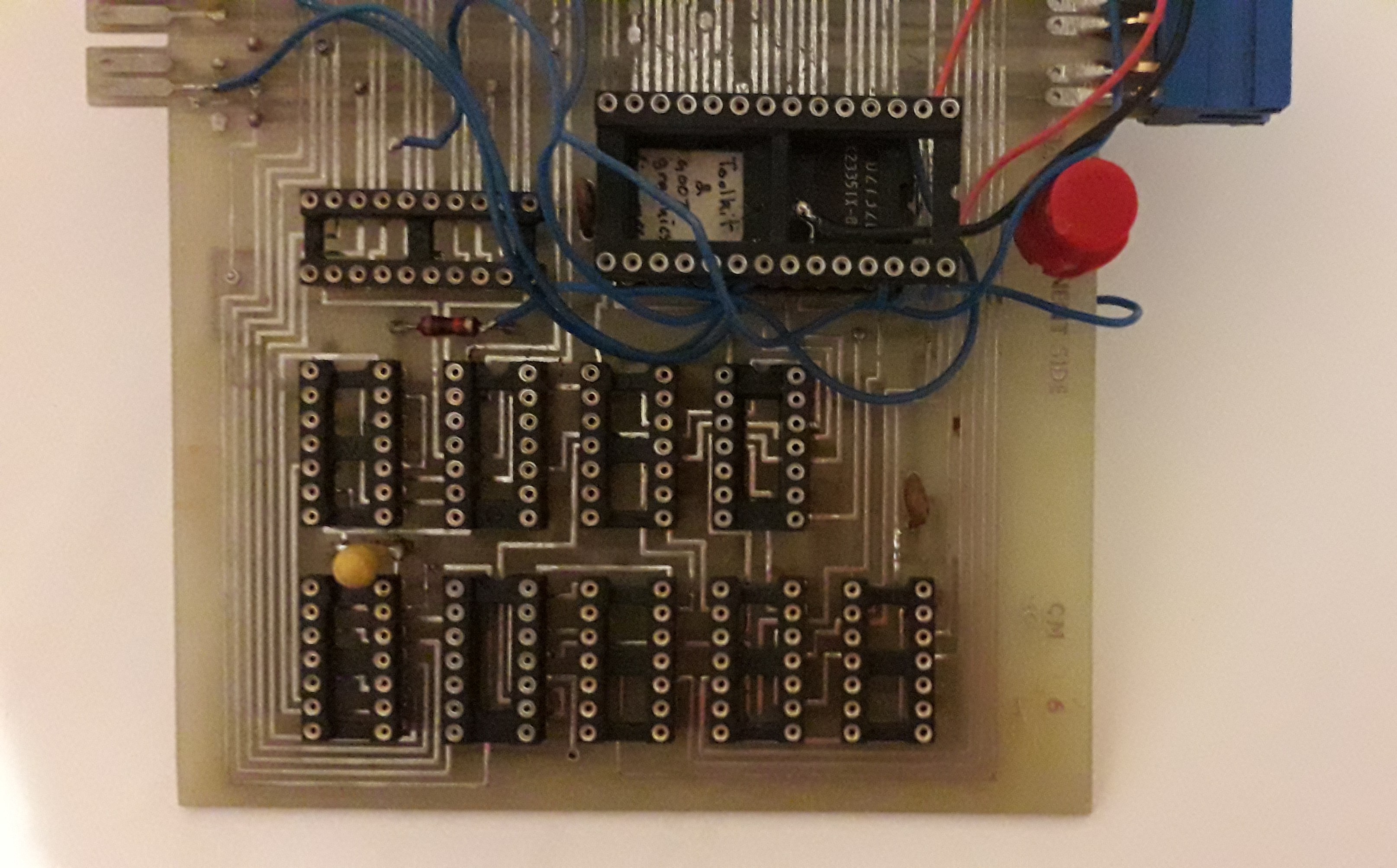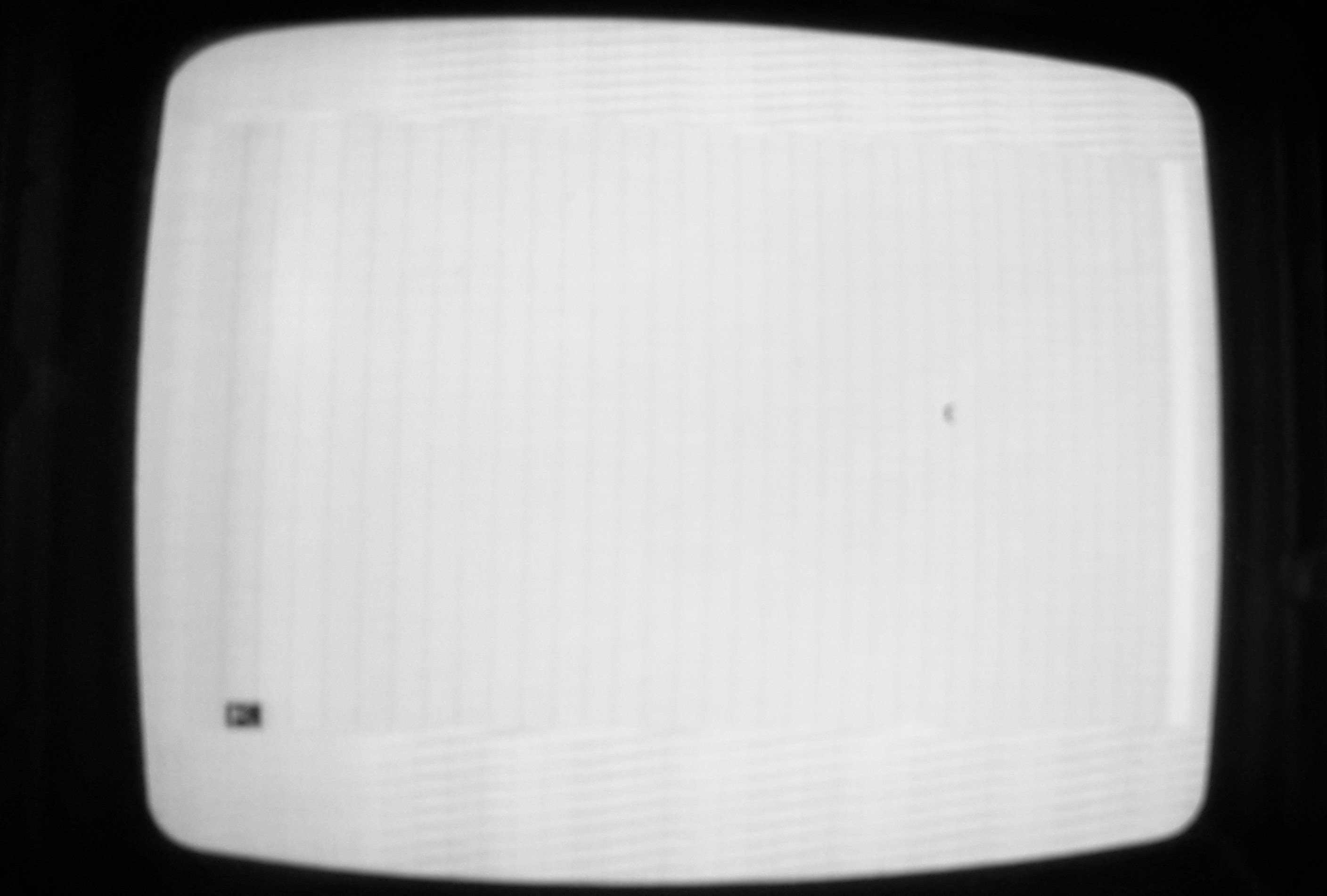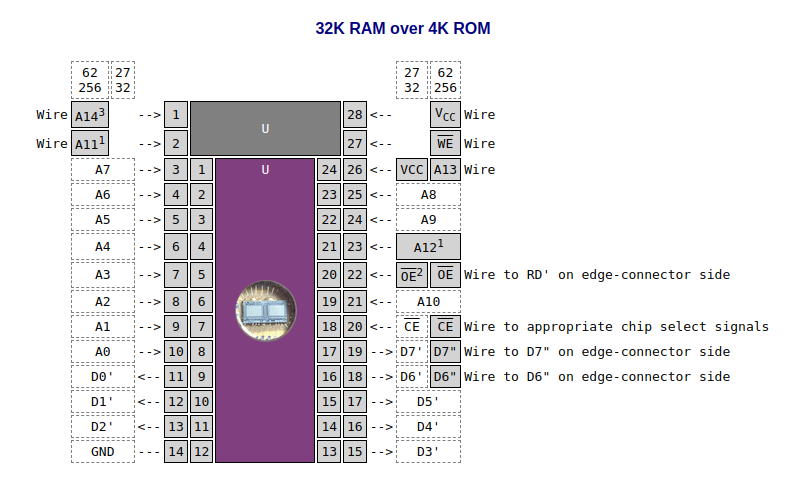-
Hacking a 16K SRAM pack
01/20/2024 at 20:16 • 0 commentsI bought a 16K SRAM pack from https://www.youmakerobots.com/sinclair/85-zx81-16k-ram-kit.html on eBay for £18.
It uses this circuit:
![]()
I assembled this and it worked fine.
The board can be modified to provide the full 32K of the RAM chip by driving RAM pin A14 from /M1 * A15.
This forces RAM A14 low when "running" the display.
The ram at $C000 to $FFFF is now not an alias of the user RAM but an extra 16K RAM that can be read and written to, but machine-code cannot be run there.
The right-hand pair of NAND gates in the LS00 chip have floating pins, which is a bit naughty but you can get away with it with TTL chips. Having floating pins makes the 32K modification easy, because the pins can be simply wired up.
The RAM A14 pin is grounded, but thankfully has thermal breaks so you only need to cut four small PCB tracks.A further mod would allow you to relocate the ZX81's on-board RAM. Maybe not worth it for just 1K (although the G007 board uses it). However, if you have up to 8K you could re-map that at $1000-$1FFFF. Or re-map bigger memories to $8000-$BFFF as well. such mods would require more logic than this 16K RAM board has available.
![]()
-
Background reading
10/07/2023 at 02:45 • 0 commentsThe basic principles of ZX video are fairly simple but there are many details that I'd rather not have to learn.
Someone who does fully understand ZX81 video - the remarkable Andy Rea - pointed me to articles written by an earlier expert, Wilf Rigter, in the ZXirQLiveAlive magazine:
Vol 6 No 4 page 19 (part 1)
Vol 7 No 1 page n27 (part 2)
Vol 10 No 3 page 7 (part 4)
Googling around, I found it in HTML (and German) and got Chrome to translate it. This gives a more readable form than the scanned magazine articles. There are a few errors such as figure numbers so I polished it up to my own style.
I've learned some interesting tricks that I'd like to incorporate into my own future designs.
- A normal 16K DRAM expansion appears when A14 is high and as a non-executable alias when A15 is high, which is fine when you have just 16K. If you have a 32K RAM expansion, half is usually wasted by tying A14 high or low. A handy and easy mod is to feed A15 and /M1 into an AND gate and wiring the result to A14 of the 32K RAM. Two diodes and a pull-up resistor will do. This means the CPU will get bytes from the lower half when it 'executes' the display file, but can read and write data to the upper half. You can't run machine code there, but you have 16K for storing data.
- Normal ZX80/81 logic forces a nop code whenever A15 is high. If you are recreating a ZX80/81, you can limit this to the last 16K (A15 and A14 high). You can then run machine code between 32K and 48K.
- The hi-res graphics methods in the article involve ANDing the /RD signal with /RFSH and feeding the result to the RAM. This reads the RAM during refresh cycles as well as the usual read cycles.
It also ties the /RFSH pin of the RAM expansion high, which prevents any refresh cycles happening on dynamic RAM boards. You are probably limited to static RAM expansion. - The address lines are driven by the I and R registers, so each video line has to execute a row of NOP codes while the I and R registers point to an "H-file".
- The G007 was designed to not need mods, the LS374 latch is there to store the bus data when a video byte "opcode" is read, and then present it to the bus during the refresh pulse when the shift register is being loaded. The address lines are driven by the program counter, using a "D-file" in a similar way as low-res video.
- The G007 method seems the best, but I'd like to be able to support both methods if possible, because there are many old programs using the Wilf Rigter method.
- Comparing the G007 and ZX80 logic looking for common circuitry, I can see a couple.
- The signal that latches the video byte is identical: MREQ & /RFSH * /CLK
and it latches the data at the end of T2.
I think it could work with just the rising edge of /RD or /M1. The ZX81+38 circuit uses /RD. Signal /M1 happens less often than /RD and thus generate less RF noise, but /RD rises sooner. - The signal selecting the latch output is /RFSH on the ZX80, and /RFSH during high-res graphics mode.
- D7 and D7 are forced low when high-res graphics mode, A15 high, and /M1 low.
It looks like G007 U7A, U9A, U1B and U1C exist just to prevent the expansion memory board D7 and D6 from being pulled low. I thought I could do Sinclair's trick of using resistors to limit the conflict (resistorplexing?), but there are already resistors in the D7/D6 signal path. If I'm integrating the G007 logic into the ZX81 logic, maybe I could pull D7 and D6 low at the CPU side of the resistors and then omit the isolation circuitry.
- The signal that latches the video byte is identical: MREQ & /RFSH * /CLK
- Most of the circuit does the memory patching. If using a pre-patched ROM, maybe this can be omitted?
-
Parts list
10/05/2023 at 00:50 • 0 commentsFor the Maplin version
Resistors
All 0.4 W 1% metal film
R1,2 1k0 2 off
Capacitors
C1-3 10nF disc 3 off
Seems a bit small. I'd fit 100n capacitors. And a 22u electrolytic.
Semiconductors
IC1 74LS126 * IC2 74LS04 IC3 74LS03 is 74LS125 on my board IC4 74LS11 IC5 74LS00 IC6 74LS32 is 74LS02 on my board IC7 74LS27 * IC8 74LS260 * IC9 74LS74 IC10 74LS374 IC11 2716(M8) * I am short of these.
Miscellaneous
P.C. Board Track pin 5 pkts Socket 24 Pin DIL Socket 2×23 way P.C. Edgecon
-
Upgrading to 32K EEPROM
09/16/2023 at 16:39 • 0 comments2023-09-16
This has to be done on the motherboard, where it doubles as the character font generator.
![]()
Note that pin 1 is on a wide 5V track, and fiddly to isolate. I've just put my code in both halves of the 28C256.
As mentioned elsewhere, the G007 board 'patches' the ZX81 BASIC to change the syntax of graphics commands.
I suspect this could be done more easily by having a ROM with two copies of BASIC, one as normal and one pre-modified. The patching logic could then be removed. However, this would have two problems back in 1982.
Firstly, much of the new ROM would be Sinclair code, and thus open to litigation.
Secondly, memory was more expensive back then. In December 1983 when the Maplin article was published, UK prices in Electronics Today International February 1983 were:
2716 £2.79 (£11.73)
2732 £2.99 (£12.57)
2764 £9.99 (£41.99)(2023 equivalent price in brackets)
I can't even seen a 27128 or 27256 in that issue, but even if the price was directly proportional to size,
then 20 or 40 pounds then would be the equivalent of 84 or 168 pounds in 2023.In 2023, one can now buy a 32K EEPROM for about £11, equivalent to the price of a 2716 in 1983.
So price isn't an issue and Sinclair no longer exists.2023-09-25
It also occured to me that the code in the 'shoulders of giants' version may be so different from the original that the ROM patching does not match, and thus fails.
So I decided to get the latest official ZX81 ROM (version 3) and compare the patched areas with the original. I found out I had done this way back in 2011-05-02.
Only 17 bytes are modified in the RAM patches. There are some differences at 07FD, 083E and 0843 which I wasn't expecting. I thought the ROM patch was at 0C00 and 2C00. Maybe the emulator used a very different board? This will need checking out.
I've uploaded the files I have created so far.
-
Getting it working again
09/09/2023 at 21:47 • 0 comments2023-09-09
For some reason, it isn't working. The 32K RAM piggy-back is working, but graphics are not.
It has been modified to take a 4K EPROM.
Quick tests:
1 LET B=11520 10 FOR A = 0 TO 8 20 PRINT PEEK A - PEEK (B+A) 30 NEXT A
I get:
128 64 32 16 8 4 2 1
This is what I expect, indicating the G007 ROM is present.
But looking at 8192 onward, all I see is 255 when I expect random RAM values. Okay, they might be 255 by chance but POKE 8192,55 does not change the value returned by PEEK.
I deduce that the G007 ROM is present but the 2K RAM that should be at 8192, is not.
There should be a monitor I can use. The original article said:
9996 STOP 9997 POKE 16417, 0 9998 RAND USR 32598; REM 7F56 9999 GOTO 9996
So the new entry point should be 32598 - 16384 = 16214
RAND USR 16214
crashes my system. I suspect the monitor RAM is not there either.
Tracing back the ZX81 /RAMCS signal from the 8K RAM pin 20, edge connector contact 2A, pin 11 of U5 gate D. A11 used to select G007 ROM/RAM. A11 is edge connector pad 1B. Seems fine, maybe ZX81 RAM is only present if in graphics mode, and the ROM is not letting it do that.
I notice that my board differs from the Maplin circuit again, as U6 is a NOR gate instead of an LS32 OR gate. I really ought to work out the circuit diagram for it.
2023-09-12
The ROM patch is always present when the G007 board is fitted, so the design could be simplified by having a ready-patched BASIC. As a bonus, the 256 byte patch is freed for other uses.
I noticed that the ZX80 circuit does not have the ROM chip select taken through a resistor to pad 23B, as it is on the ZX81.
This explains why my ZX80 was not accepting G007 commands. The BASIC ROM was simply not being patched.I went to mod my modern board when I noticed it does have this feature but only if you make jumper 99. So I did.
I now find I when I type in lines of BASIC, it now crashes after pressing NEWLINE.
Clearly the BASIC ROM is now being patched, but badly! Oh well, it is a step in the right direction.
2023-09-14
I found the numerous non-connections between the ROM and RAM chip data lines were due to most of them being swapped around. And the Z80 was not fully seated in its socket. So I pressed the Z80 down and ... it still isn't working. Checked the ROM socket modified for EEPROM - found /WE floating. Tied this high. Something poorly visible on screen. Adjusted TV from white-on-black to black-on-white levels. Hurrah! it works!
I know the 32K RAM circuit works when the ZX81 /ROMCS is not connected, so I think the problems are now just down to the G007 ROM patching circuitry. My board circuit differs from the Maplin version, so I will have to reverse engineer it before proceeding.
2023-09-26
It is possible that the G007 board is not compatible with the heavily corrected 'shoulders of giants' version of ZX81 BASIC so to remove this possibility I created a reference ROM with ZX BASIC edition 3 at location 0000. It is a 32K EEPROM, so in the second half I have put the same BASIC ready-patched with G007 firmware, plus the 2K G007 ROM and a 2K monitor.
This ROM boots up to a stable cursor. I'd like to do more but the plastic film keypad broke. So the next job is to wire up my new PCB keyboard.
2023-09-27
New keyboard wired in. The new ROM now accepts new BASIC syntax like "10 CLS 2" and "20 PLOT N, X, Y" although it does return errors if you try to run it. The ZX81 RAM will not be at 2000-27FF where it is expected.
With the G007 board fitted, the video is very poor, probably due to clashes. Further work required.
2023-09-29
More thinking. I had a glance at the ZX97 design and resolved to add any nice features from there. The ZX81 uses up to 16K RAM, and most people just use half a 32K SRAM chip. The other half is usually wasted. Most software was written for 16K RAM machines so there isn't much need for any more. However, you can enable the spare RAM at 2000-3FFF hex if you want an extra 8K RAM that isn't wiped at reset. The ZX97 design allows you to boot from ROM, jump elsewhere, then disable the ROM at 0000-1FFF hex which is then replaced by RAM. You then have a machine that you can load with any firmware you wish.
This is desirable because you won't need to use a device programmer every time you want to try something new. Also, some versions of BASIC are mostly the same with a few bytes changed, so a boot ROM can store one copy and then patch it with a few bytes instead of using switches to select one of several 8K versions. This produces a much more hackable machine, and that's what we are into.
2023-10-01
I accidentally tried it with a DRAM pack and the 32K piggyback RAM fitted, and noticed the video was much less noisy. I would have expected conflicts, but if you write to both then the data will be the same read back from both. Okay, so maybe a noisy data bus? Applying my finger to the data lines affected the video noise, reducing it somewhat.
I tried replacing the original 4K ROM, which is over 40 years old. This made no difference, and the original read back the data expected. So it is not bit rot.
Removing the piggyback RAM kludge did not help. At this point I'm getting a bit fed up, and would just like to start replacing chips until I find the culprit.
2023-10-02
Replaced the chips with sockets today. I took a photo before fitting the sockets, in order to record the PCB tracks:
![]()
Some pads lifted and missing but none went anywhere on top.
One pad did have a track but it will be held down by the IC sockets.
I noticed one of the ceramic caps was missing. Could this have been the culprit?
Three ceramic caps is rather frugal, especially as they are marked 10n 25V. I'd normally expect 100n per pair of 74LS chips.
![]()
I fitted a 22u capacitor on the top, as there was no low-frequency decoupling at all. I can tack surface-mount 100n caps under the board at a later date if I wish.
I plugged it between a ZX81 and a 16K DRAM pack, to check there was no fault caused by the bare PCB. Switching on produced a mess of video. I needed to tie the ROM nCS signal high. After that, it booted up much better.
I noticed there was a single unexpected "(" character (hex 10) on the screen. Sorry about the poor photo, my camera has trouble focusing on things flickering at 50 Hz.
![]()
It seemed fairly stable so I had a go typing some BASIC. Nothing reliant on the G007 graphics hardware that is no longer there. It ran, but I would get error codes like "R/10" which I expect are the software's way of saying "I can't find the ZX81's RAM at 2000 hex".
I can get round this by kludging a suitable memory decoder.
2024-01-06
I changed the 32K RAM on the ZX81 to an 8K RAM, so that it will be aliased in the 8K BASIC ROM space when required by the G007. It starts up and reports RAMTOP is 24K, as expected. The ROM occupies the first 16K, with the first 8K being original ZX81 BASIC, and the 8K after that being blank (hex FF) to avoid any confusion with any other ROM. The ZX81 seems to work, although it sometimes crashes which I suspect may be due to me touching the underside of the keyboard with my hands and picking up RF noise.
I replaced the last chips needed in the G007 sockets. It failed to work with my ZX81 and DRAM pack. I shall have a look at my ZX81 to see if it was hacked in such a way as to prevent it working. Alas I don't have time right now so I'll shelve it until I do.
2024-01-06
Not knowing which of the boards are at fault, I ordered a second ZX81, which has not been modified by me. It cost me £53 but it will save more than the equivalent cost of my time. And I can always sell it later, when I no longer need it.
2024-01-11
New ZX81 arrives. It is issue 1, all chips socketed and the RAM is a single 1K x 8 chip. I modified the video to bypass the modulator. It needs a mains plug fitting to the PSU, which I shall do tomorrow.
2024-01-13
Plug fitted, unit dead. Thankfully just the PSU dead, I'll look at that some other time. Isolated the 7805 regulator output and added a 2.1mm socket on flexible wires. Unit works! Added my DRAM pack, it does not work. Which is good news because it means the DRAM pack is at fault and not my ZX81s. So now I have to fit a RAM chip to my G007 board.
Despite checking the signals ( /RAMCS = A14 & MREQ), still not working.
Okay, now to disable all G007 apart from the 32K RAM?
Removed the LS374, 125, 126 chips and wired D6 and D7 to ZX81 side. No joy, even with ZX81 RAM out..
Remove the LS00 driving the ZX81 ROM/RAM chip selects and the G007 ROM CS line (U5 pin 3), and removed ZX81 RAM. No joy.
Removed all other TTL chips from G007. No joy.
Fitted ZX81 RAM. No joy.
Removed 32K RAM from G007. Works! So some kind of RAM conflict?
G007 only has ROM, U7(LS27), and U2 (LS04) now.
Restored all chips apart from the LS126 (drives D7 and D6), the LS374 (drives data bus), and the LS00 (drives memory chip selects), and it still works with ZX81 RAM and no G007 RAM. Could I have a dead RAM? A fresh RAM works in the G007 with no ZX81 RAM. I check and find I had been using a TC53512 which is a 64 kbyte mask-programmed ROM.
Hoping this was the reason it was failing, I fitted the remaining chips. Alas, not working!
Adding some decent decoupling capacitors did not help.
2024-01-20
I built a separate static RAM pack to isolate the issue. The RAM pack worked fine with both ZX81s alone, but the G007 stopped the system working so I am now sure it is the sole cause. I suspect the piggy-backed RAM is working fine, because the decoding logic is the same as the RAM pack I bought.
2024-01-23
More jiggery-pokery and still not working.
-
Upgrading to 4K EPROM
09/09/2023 at 20:49 • 0 commentsI modified the board so I could add a 2K monitor code at 3800:3FFF.
This requires:
- 4K EPROM (2732)
- pin 21 isolated from VCC and wired to A12 (not A11)
- U3C pin 9 being isolated from A12 and then tied to ground.
-
Adding a 32K RAM chip
08/31/2023 at 00:51 • 0 commentsEdge connectors should not be used as the sole means of supporting a board, especially cheap ones without gold-plating.#
This is exactly what Sinclair did with the ZX81, rendering it completely unreliable.
The G007 can't avoid the connector between it and the ZX81. To avoid the connection between it and the 16K RAM pack I added a 32K RAM chip, piggy-backed over the G007 EPROM (with which it shares many pins in the same places. I did this ages ago,
2023-09-02
I gathered my Sinclair related kit: a ZX81, a five-inch monochrome telly and a matching 12V 1A wall-wart power supply. Those seem to work fine.
2023-09-03
My ZX80 clone seems okay but my ZX81 is not. So I'll work with the ZX80 for now. Both have 32K RAM fitted.
Neither work with my G007 with a 32K RAM chip. I checked the wiring. I noticed /OE and /CS were joined, as I have seen done for read-only memories. I guess I had been hacking it to carry a ROM. So I modified RAM /OE to go to /RD. The /CS pin can be driven by A14 NANDed with MREQ, as shown in the image below:
![]()
The RAM piggy-backed over 4K EPROM signals are mostly in the same place.
![]()
Notes:
- 24-pin ROM pin 21 is tied high for a 2716, A12 for a 2732, and A11 for larger chips.
- G007 board joins ROM /CE and /OE. It could be changed to /RD.
- 32K RAM pin 1 is connected to A14 but the ZX81 normally only selects it when A14 is high.
- RAM D6 and D7 must go to the edge connector side of the G007 board, so they can be isolated during pixel graphics.
- RAM /RD must go to the edge connector side of the G007 board, if using the Maplin circuit.
If there is a 32k RAM on the ZX80 and the G007, the G007 logic will only select parts of it.
I then realised there was a sneaky problem with the patching method. The firmware copies pages from 0000h and 0200h in ROM to 2000h and 2200h in RAM, makes a few mods, then enables RAM at the lower pages, replacing the ROM. If the on-board RAM is bigger than 8K, the higher pages of RAM will not be aliased at the lower pages. Instead, you will get pages of uninitialised RAM, and the system will fail.
So I replaced the 32k chips with 8k chips. The ZX80 clone still works. It says 256*PEEK 16889 - 16384 is 8192 without the G007 and 16384 with the G007. The latter is correct because only half the chip is being used at the moment.
There is a similar aliasing problem if you try to fit the ZX81 BASIC and G007 in a single 16k ROM. The aliasing won't work. It will need A13 to be forced high when accessing page 0Cxx in order to select page 2Cxx in graphics mode.
The system is not implementing G007 graphics commands at the moment. I don't know why, right now. I'd like to try it with my external 16K DRAM pack, but this is lacking a chip (I suspect an LS32). I must have borrowed that for another project but I can't recall where.
2023-09-05
The 16K DRAM pack worked after fitting a 74LS32. Either if fitted alone, with or without RAM on the ZX80, or the G007 board without RAM. BASIC did not have new G007 commands, the ZX81 ROM was not being patched because a link was missing. When I fitted that link, it crashed the system.
2023-09-17
Today I wondered if I could create a single unified ROM to replace the ZX81 and G007 ROMs. I think it might be possible but the would have to be on the ZX81 board so that it can work as the character font ROM.
Meanwhile I feel I should try getting my G007 back to working before trying anything new.
ZX81 hi-res graphics board G007
By Gary Keall. 256x192 pixels. Patches BASIC so you can PLOT(n,x,y) instead of USR(addr) calls.
 Keith
Keith